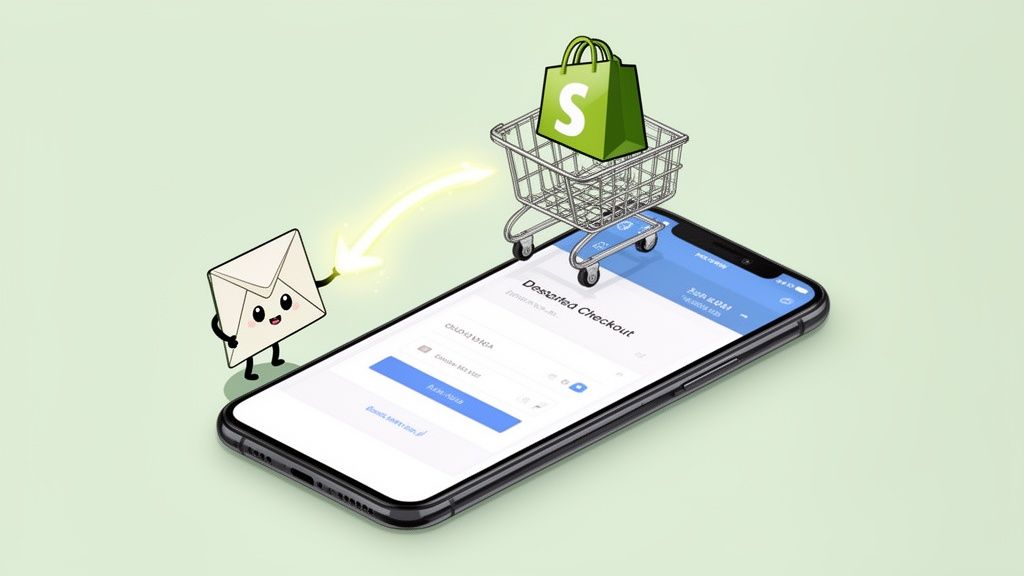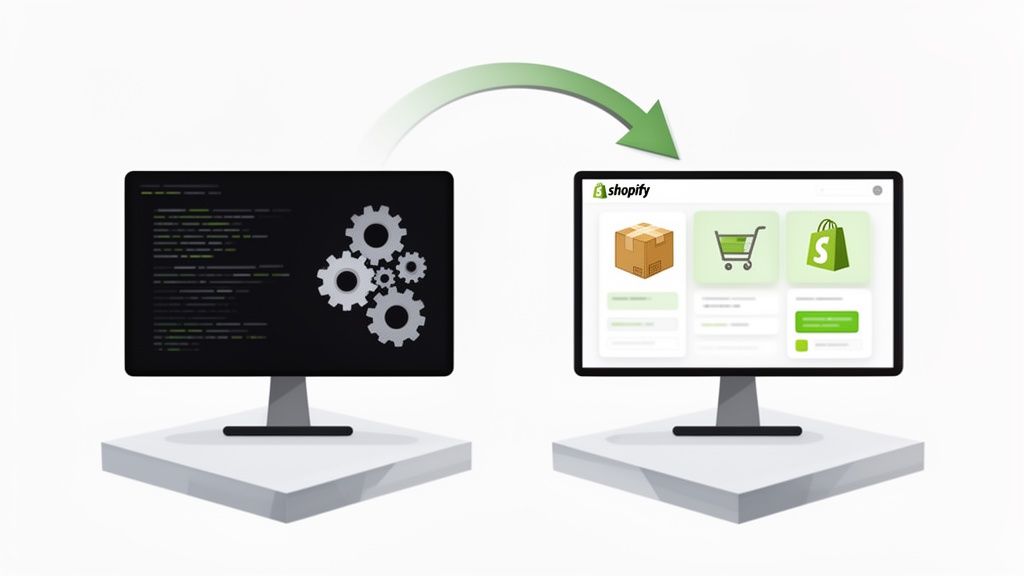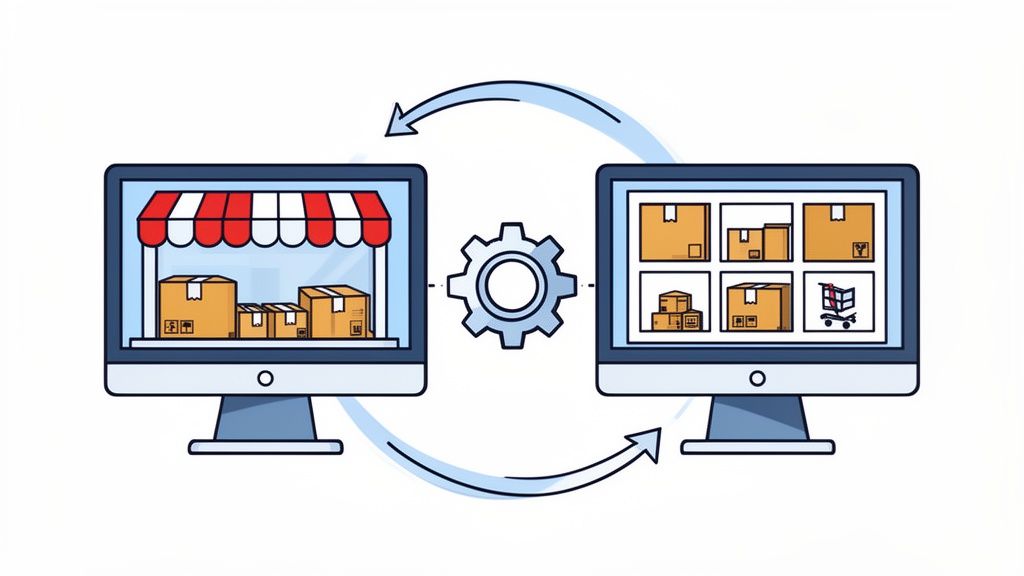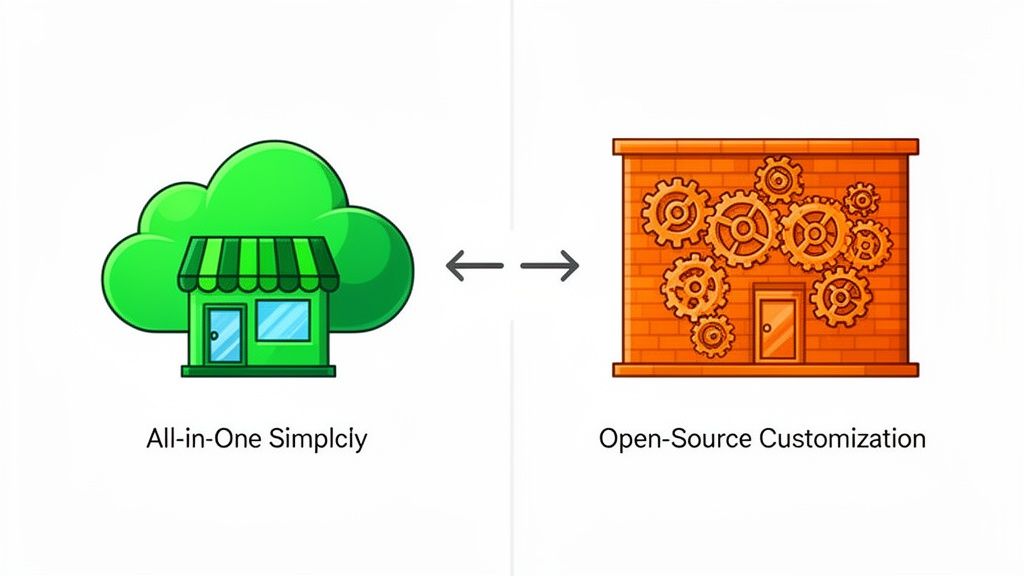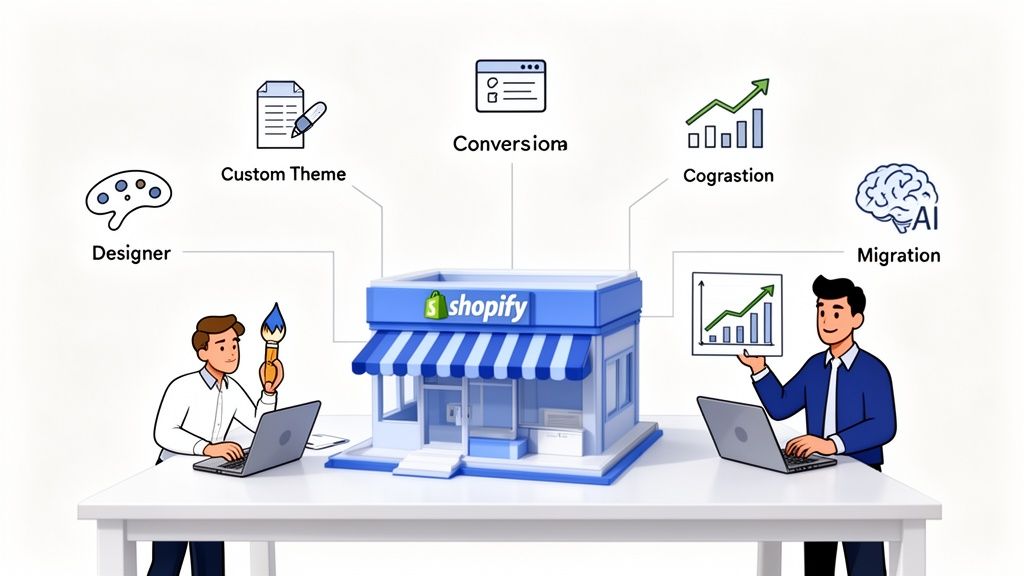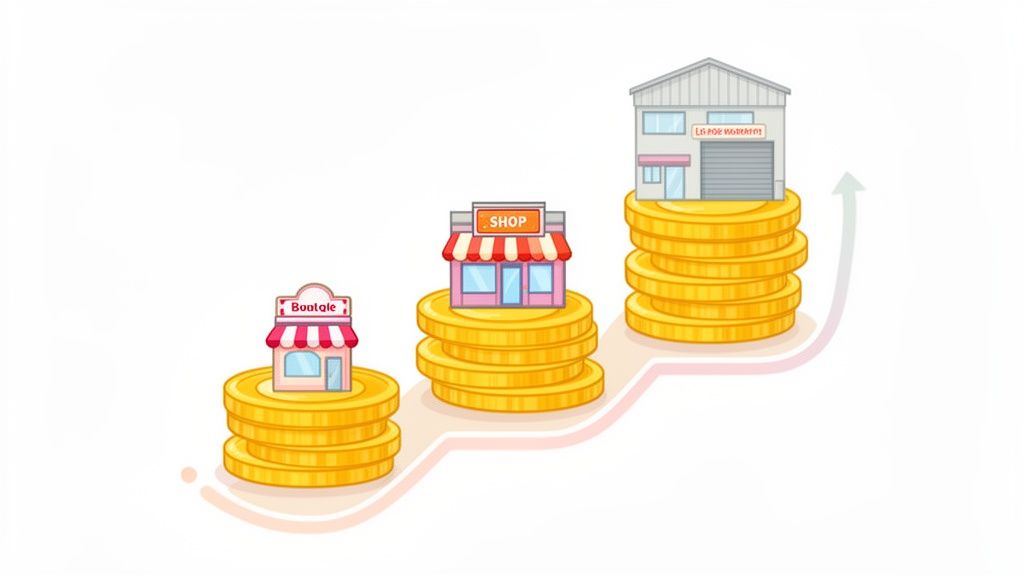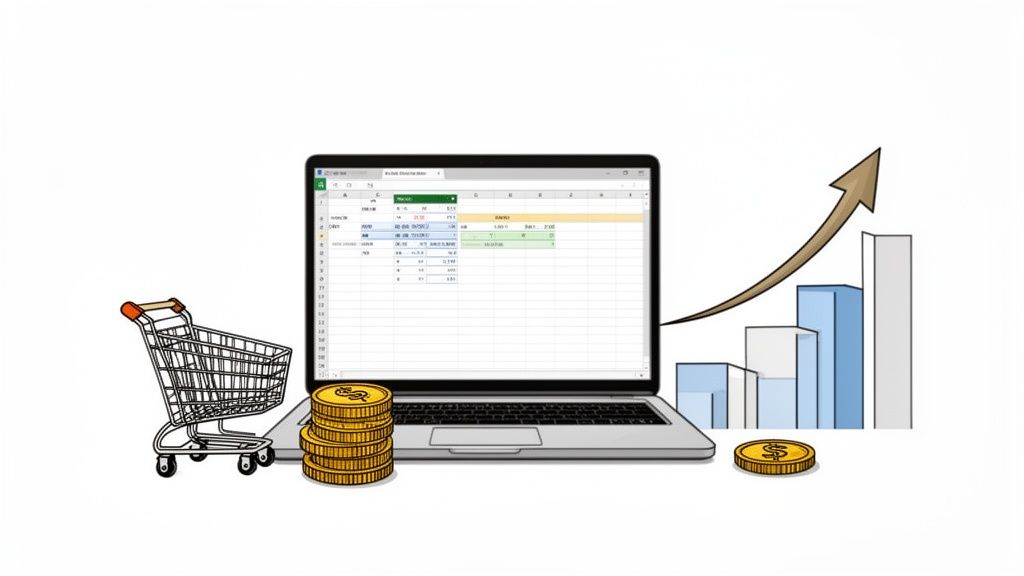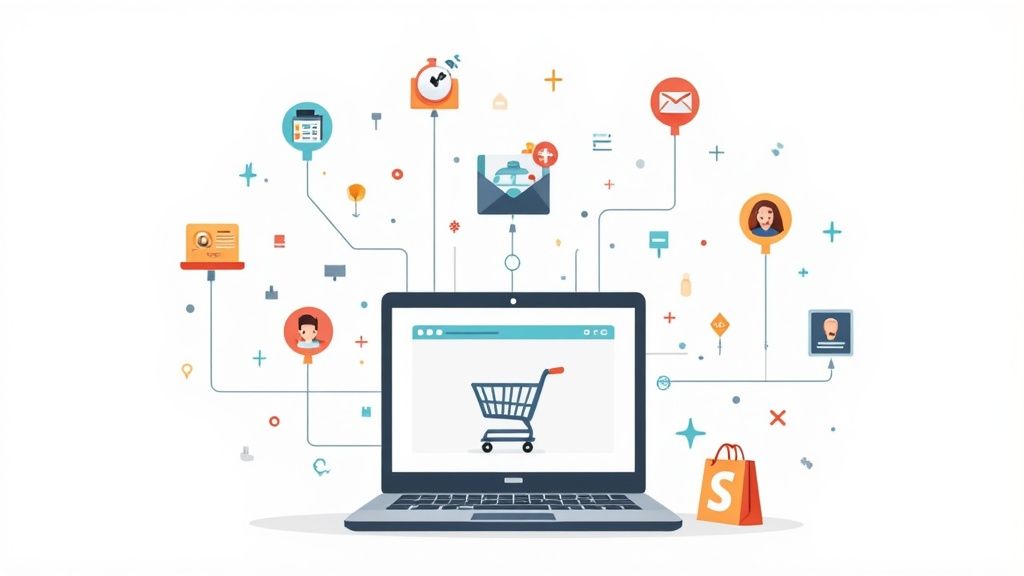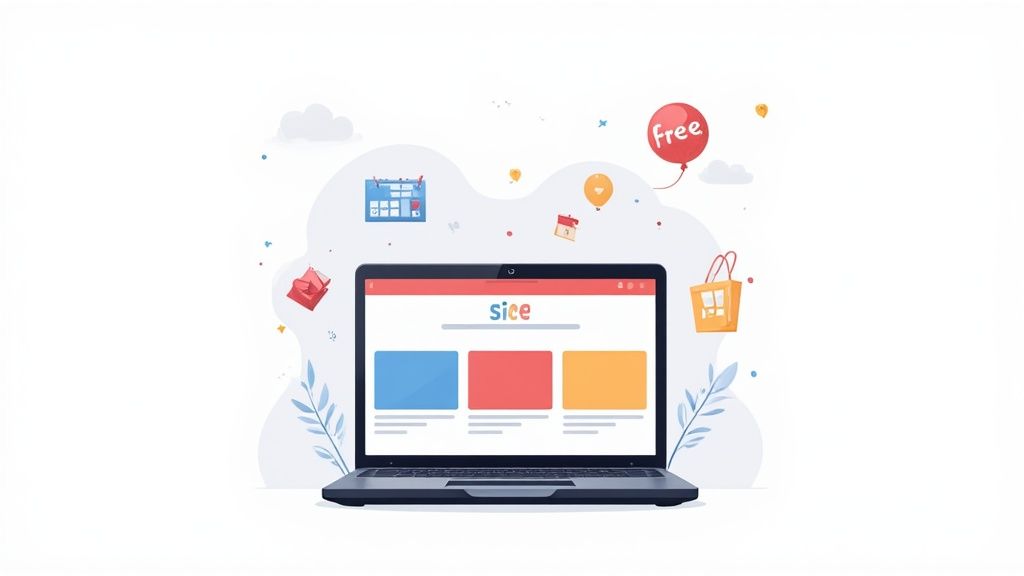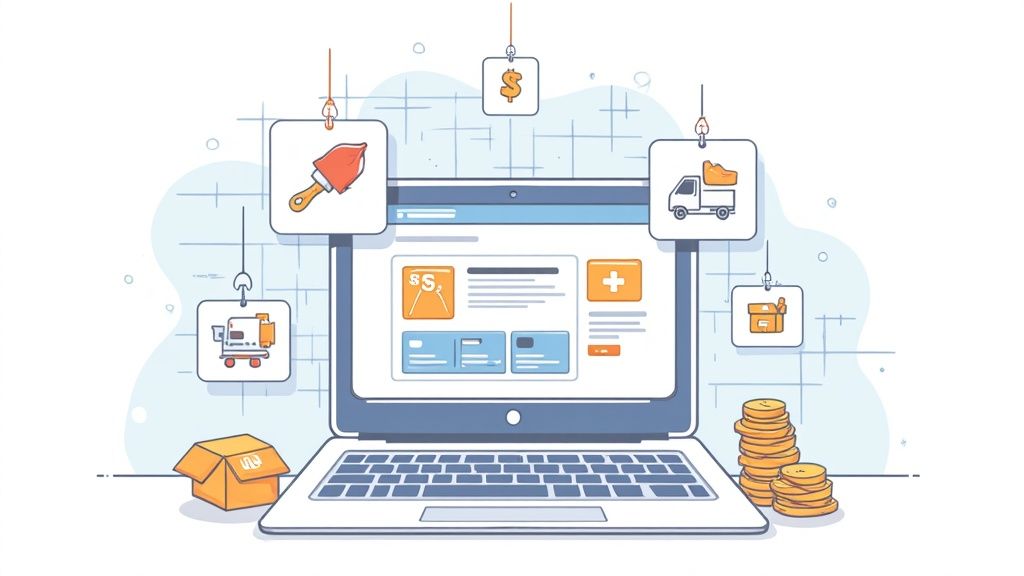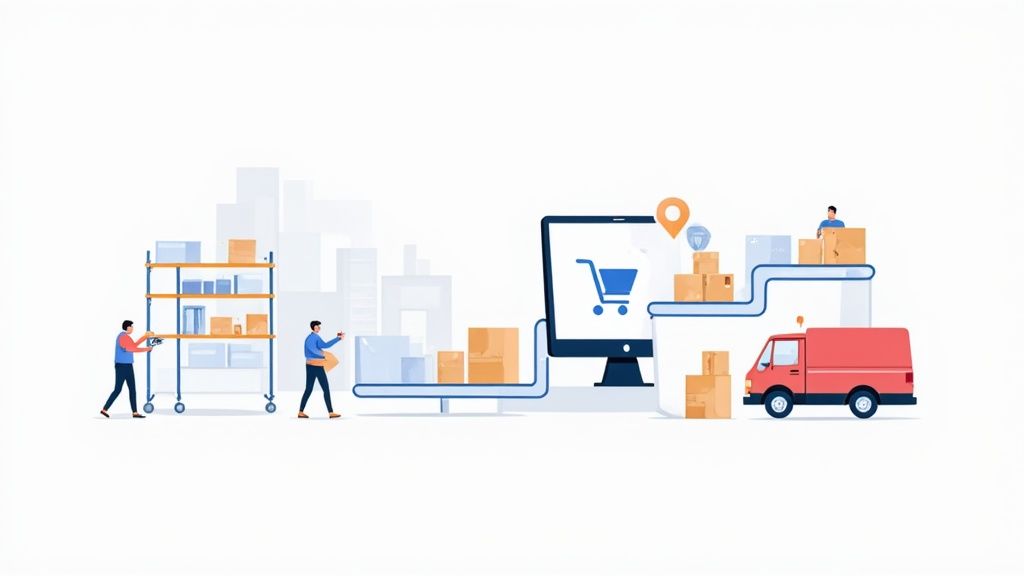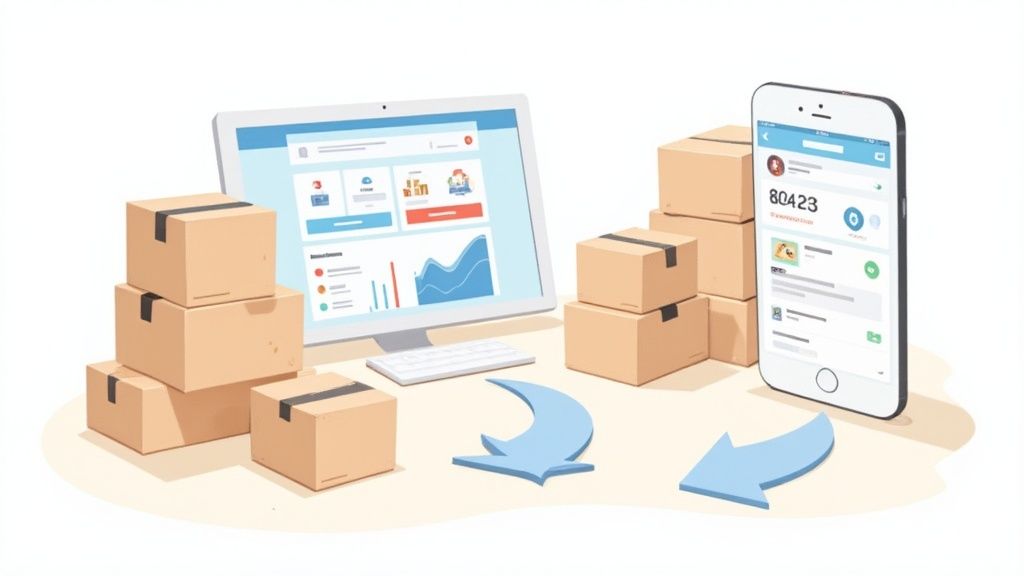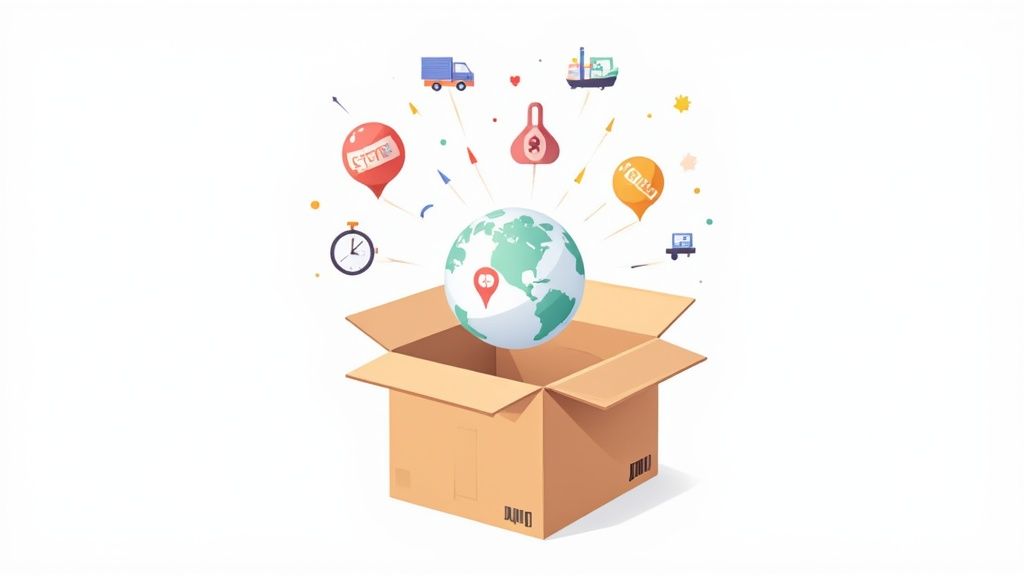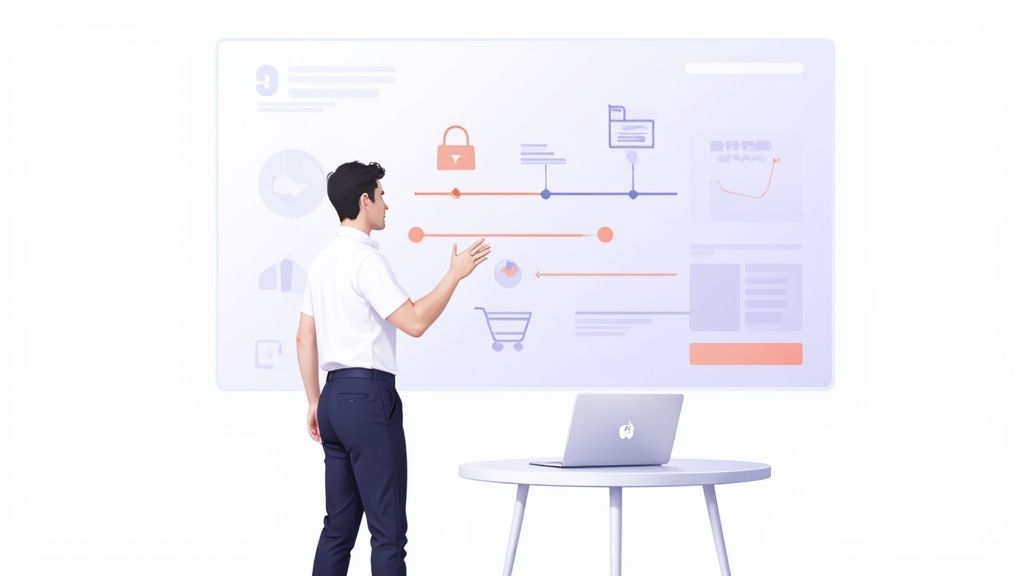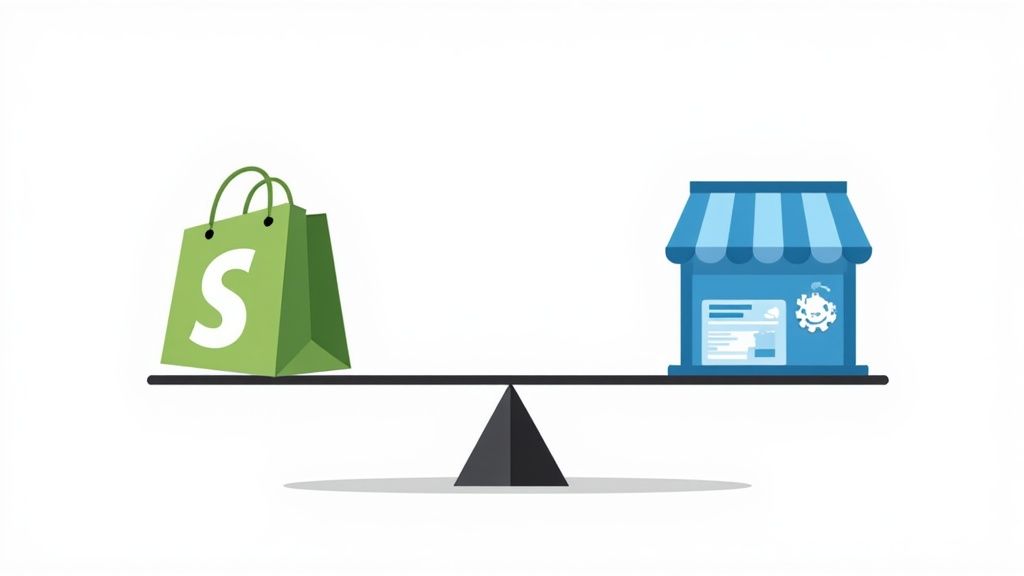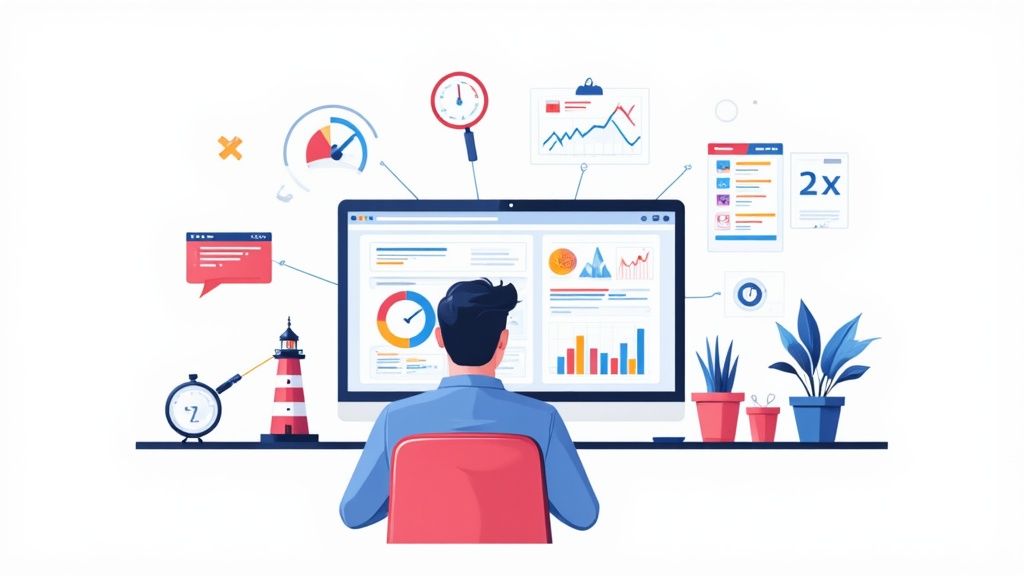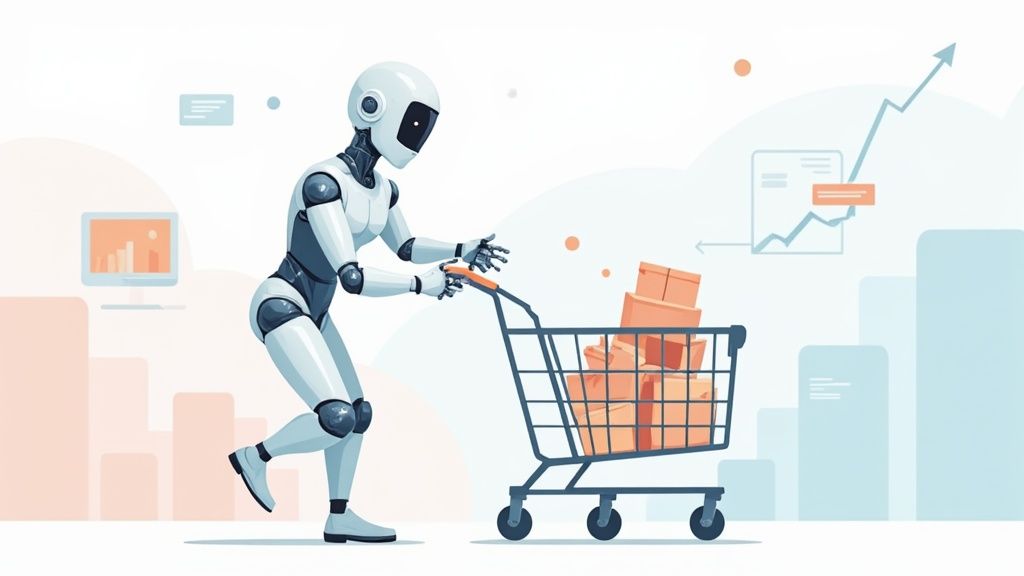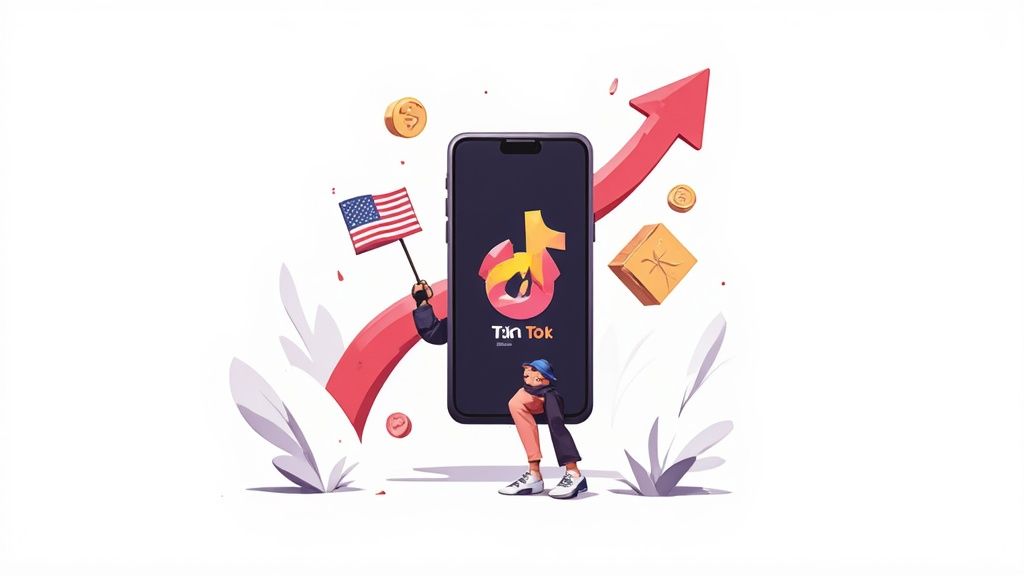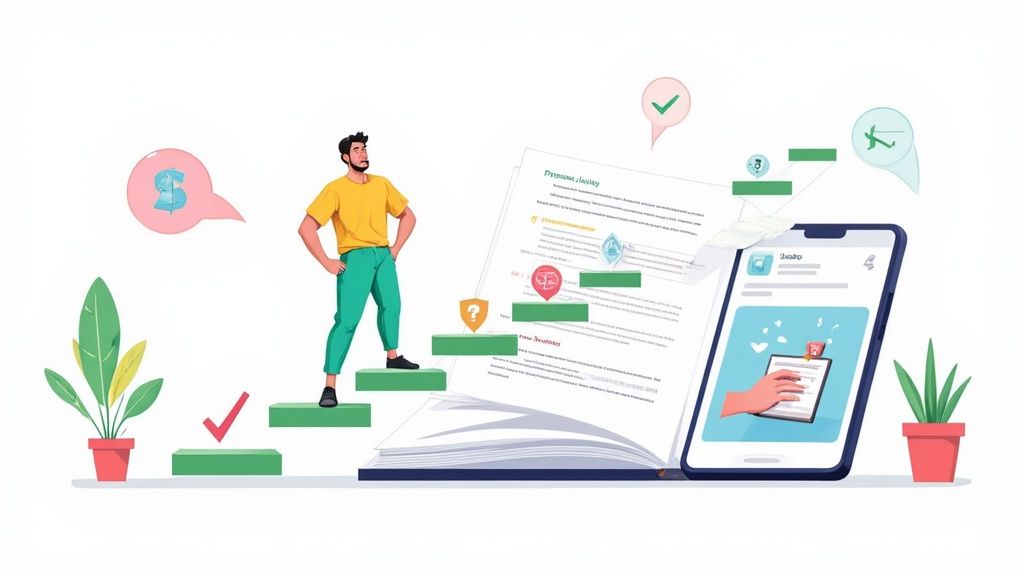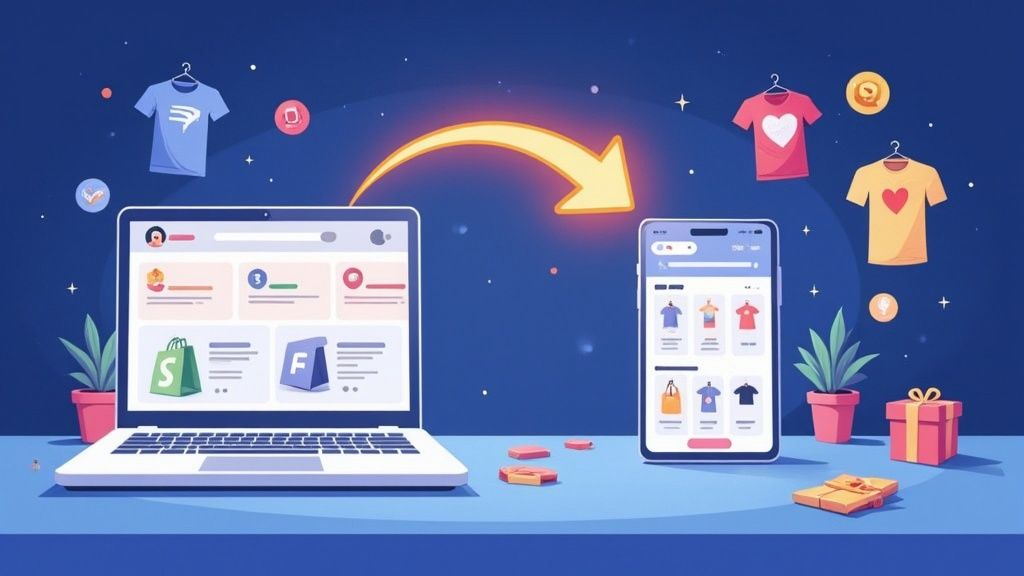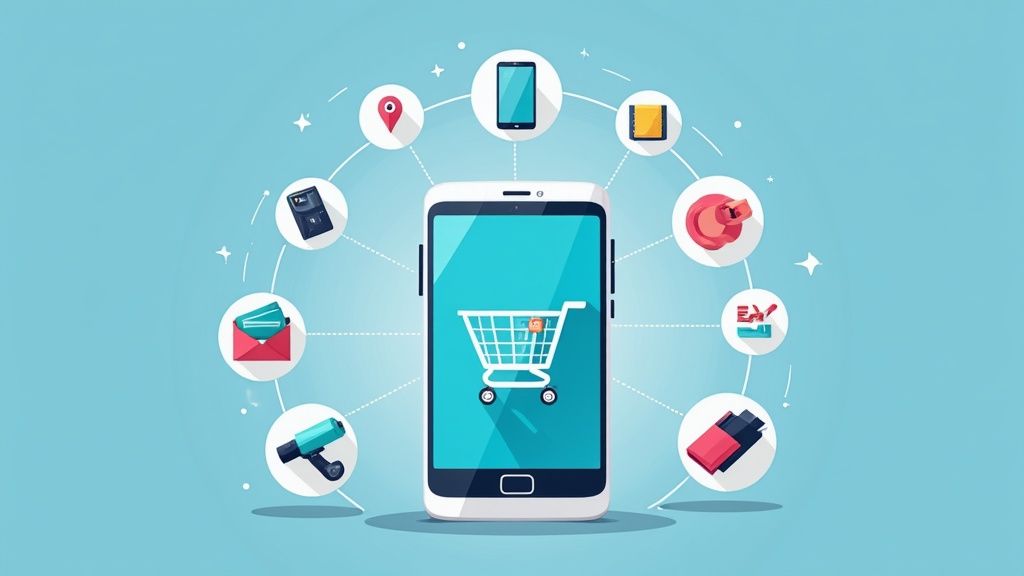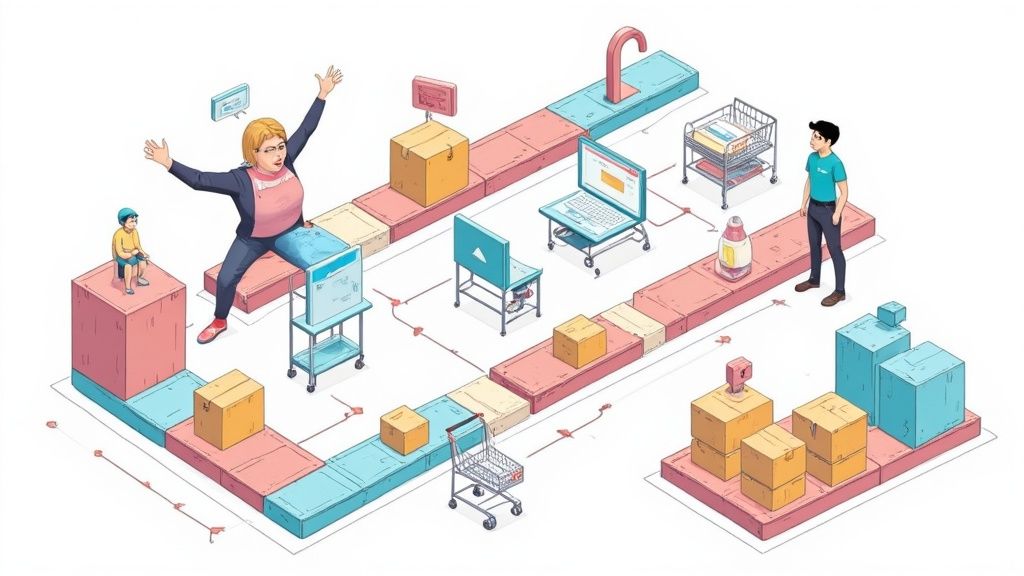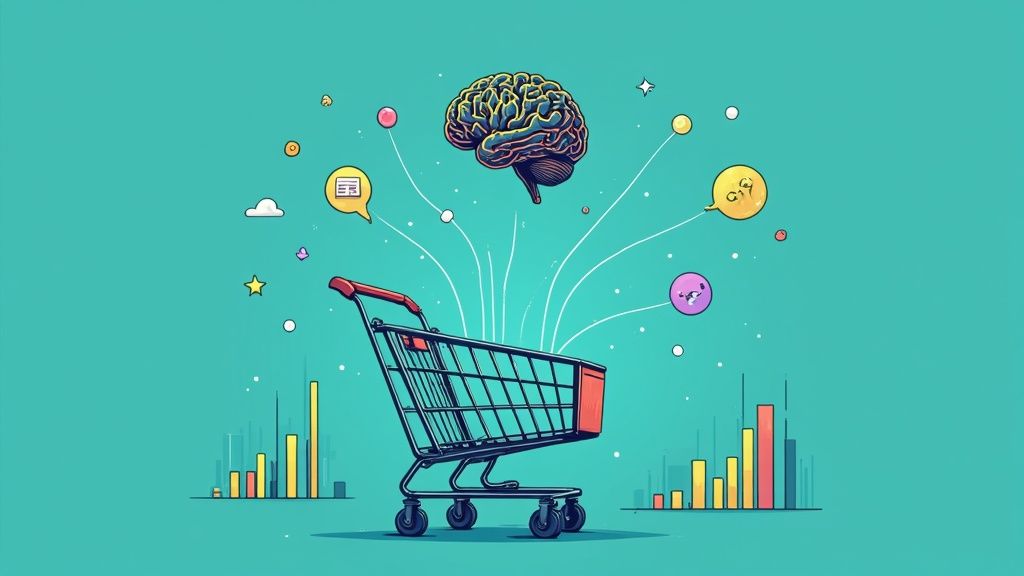
At its core, machine learning for retail is about using artificial intelligence (AI) to sift through massive amounts of data, predict what customers will do next, and automate important parts of the business. Think of it as a strategic partner, helping you make smarter, data-driven decisions that boost efficiency and, ultimately, your bottom line. This isn't some far-off concept anymore; it's a fundamental tool for staying competitive.
The New Reality of Smart Retail
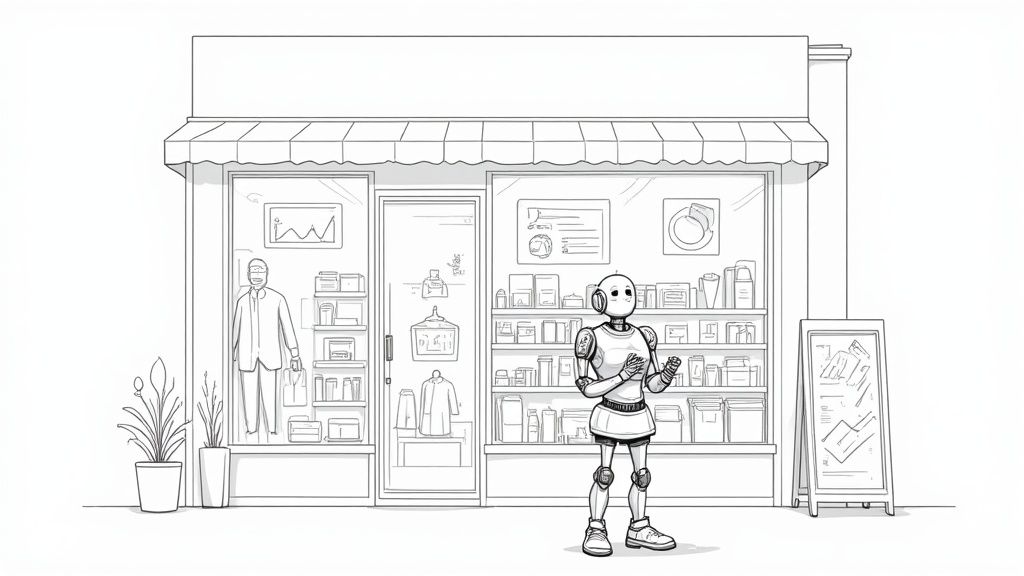
Imagine having a personal shopper who could anticipate the needs of millions of individual customers all at once. That's the real power of machine learning for retail. It's not about flashy tech for its own sake; it's about solving the real-world problems you face every day, from climbing operational costs to tangled supply chains.
By digging into historical sales data, current trends, and customer interactions, machine learning models can spot patterns that are simply impossible for the human eye to see. This turns raw data into actual intelligence, answering critical questions like, "Which products will be hot next season?" or "When should we run a sale for the biggest impact?"
Why Machine Learning Matters Now
Let's be honest, the retail world is tougher than ever. Customers expect personalized experiences, instant service, and for the products they want to be in stock. Just relying on gut feelings or old-school forecasting methods won't cut it anymore. Machine learning gives you the predictive muscle needed to get ahead of these demands.
This shift is clear in the market's explosive growth. By 2025, the global Machine Learning in retail market is expected to hit roughly $3.76 billion. That growth is fueled by businesses using ML for everything from personalizing the customer journey to untangling their supply chains. You can get a deeper look at these market trends in the full research from Archive Market Research.
Bringing machine learning for retail into your business is a strategic move toward building a more resilient and profitable operation. It gives brands the power to:
- Drive Personalization: Serve up product recommendations and marketing that actually resonate with individual shoppers.
- Boost Efficiency: Put inventory management, demand forecasting, and pricing strategies on autopilot.
- Increase Profitability: Cut down on waste from overstocking, stop losing sales to stockouts, and get a better return on your marketing spend.
In essence, machine learning transforms a retailer from being reactive to proactive. Instead of just responding to what happened last week, you can accurately predict and prepare for what will happen next month.
In this guide, we'll break down exactly how this technology works, showing you practical ways to put it to use. We'll start with the basics and move into more advanced strategies, giving you a clear roadmap to bring machine learning into your own retail operations.
How Machine Learning Actually Works in Retail
Let's cut through the jargon for a second. The easiest way to think about a machine learning model is to imagine you’ve just hired a new employee who is an incredibly fast learner. You wouldn't just hand them a thick rulebook and expect them to get it. Instead, you'd show them thousands of examples of how things have been done before.
Say you want this new "employee" to predict which products are going to fly off the shelves next month. You'd feed it all your historical sales data—every single transaction, what was bought, when it was bought, who bought it, and where they live. The model then pores over this data, spotting subtle patterns a human analyst would almost certainly miss.
It might notice something like a 5-degree drop in temperature in a specific region consistently leads to a spike in sweater sales two weeks later. This process of learning from past examples is what we call training. Once it's trained, the model can make incredibly sharp predictions using brand-new data, turning your raw numbers into real, actionable intelligence.
The Main Types of Machine Learning for E-commerce
Just as you wouldn't train a warehouse manager and a digital marketer the same way, different machine learning models are built for different jobs. For e-commerce, there are three key types you'll want to understand: supervised, unsupervised, and reinforcement learning.
This visual breaks down how each type of machine learning can power up different parts of a retail business.

As you can see, these aren't just abstract concepts. They have a direct line to your bottom line by improving sales, tightening up inventory control, and creating a better customer experience.
To make this even clearer, let's break down the three main types of machine learning and see how they apply directly to a retail setting.
Types of Machine Learning and Their Retail Applications
Each of these methods opens up different possibilities for your store. Supervised learning is all about making predictions based on what's happened before, while unsupervised is about discovering brand-new insights hiding in your data. Reinforcement learning takes it a step further by actively making decisions to get the best result.
Let's look a little closer at each one.
Supervised Learning: Predicting the Future
Supervised learning is like studying for a test with a complete answer key. You give the model "labeled" data, which means you provide both the problem and the solution. For example, you could show it data from all your past marketing campaigns—ad spend, channels, duration—and label each one with its final sales uplift.
The model works backward to understand the relationship between the campaign details and the sales result. Once it's trained, you can feed it the plan for a new campaign, and it will predict the likely outcome before you spend a single dollar.
- Its Superpower: Forecasting and prediction. This is the magic behind demand forecasting, predicting a customer's lifetime value, and figuring out which of your leads are most likely to actually buy something.
Unsupervised Learning: Discovering Hidden Groups
Now, imagine giving your new hire a massive, unorganized pile of customer receipts and just telling them, "Find interesting groups in here." That's unsupervised learning. The model gets a mountain of unlabeled data and has to find its own patterns without any hints.
It might come back and show you a hidden customer segment you never knew existed—like "late-night shoppers who only buy high-margin accessories on weekends." That kind of insight is pure gold for creating hyper-targeted marketing that really works.
- Its Superpower: Customer segmentation and pattern discovery. It's perfect for finding natural customer clusters for personalized marketing or revealing which products are most frequently bought together (what's known as market basket analysis).
The Bottom Line: Supervised learning is about prediction—using past results to forecast the future. Unsupervised learning is about discovery—finding new, unknown patterns in the data you already have.
Reinforcement Learning: Learning from Trial and Error
Reinforcement learning is the most hands-on of the bunch. Think of it like a model playing a video game. The model (the "player") operates in an environment (your online store) and learns by taking actions to reach a goal (like maximizing profit).
When it takes an action that leads to a great outcome, it gets a "reward." When it makes a mistake, it gets a "penalty."
A classic retail example is dynamic pricing. The model can adjust product prices in real-time based on demand, what your competitors are doing, and how much stock you have. If a price drop leads to a huge, profitable surge in sales (a reward), it learns to use that strategy again in similar situations. This continuous feedback loop helps it develop incredibly sophisticated strategies all on its own.
- Its Superpower: Real-time optimization. This is what you use for dynamic pricing, personalized promotional offers, and optimizing your supply chain logistics on the fly.
Making the Customer Experience More Human with AI
This is where machine learning for retail stops being a back-office tool and starts getting personal. AI is completely changing how customers connect with brands, transforming every single interaction into an opportunity for a more relevant, engaging experience. We're talking light-years beyond the old "you might also like" widgets.
Think of modern personalization engines as a dedicated personal shopper for every customer. They look at browsing history, previous purchases, abandoned carts, and even what’s trending right now to serve up predictive recommendations that feel like they were picked just for them. This creates a smooth, intuitive journey that builds real brand loyalty.
To see what this looks like, let's follow a typical customer journey powered by machine learning. Meet Alex.
From First Glance to Final Click
Alex’s journey kicks off with a perfectly timed ad on her social feed for a jacket. It’s a style the AI model flagged as a likely fit based on her recent browsing patterns. She clicks, and instead of landing on a generic homepage, she’s greeted with a curated collection of products that match her taste—all arranged in real-time by the algorithm.
As she browses, the product recommendations shift and adapt on the fly. The AI isn't just pushing popular items; it's suggesting accessories and coordinating pieces that specifically complement the jacket she’s looking at. This kind of thoughtful detail makes the whole experience feel less like a transaction and more like a helpful conversation.
Seamless Support and Post-Purchase Care
After adding the jacket to her cart, Alex has a quick question about sizing. Instead of getting stuck in a support queue, she opens up an intelligent chatbot. This isn't one of those frustrating, rigid bots. It’s a conversational AI that actually understands her question, pulls the sizing chart info from the product page, and gives her an instant, clear answer.
This kind of immediate, 24/7 support is a massive part of the modern customer experience. And once Alex checks out, the AI's work still isn't done. It triggers a follow-up email with care instructions for her new jacket and even suggests a matching scarf that just came in stock. It's anticipating her next need before she even thinks of it.
This entire flow—from a predictive ad to a personalized storefront and instant support—shows how machine learning builds the kind of memorable experience that keeps people coming back.
The goal of using machine learning for the customer experience is simple: make every interaction feel effortless, personal, and valuable. It’s about building a relationship, not just processing a sale.
The impact of these tools is already clear. The most popular AI applications in retail are squarely focused on these customer touchpoints. Personalized recommendations are now used by 47% of retailers, conversational AI bots by 36%, and adaptive advertising by 28%. These numbers point to a major shift toward smarter, more responsive customer journeys. You can dive deeper into these trends with Itransition's machine learning research.
Building Loyalty Through Intelligence
By anticipating what customers want and removing any friction in their path, machine learning for retail does more than just lock in a single sale. It lays the groundwork for real, long-term loyalty. When a customer feels seen and understood, they're far more likely to return, spend more, and tell their friends about you.
Here are a few of the key applications changing the game:
- Hyper-Personalization: Algorithms sift through massive datasets to deliver one-to-one marketing messages, product suggestions, and site content that truly connects with each individual shopper.
- Intelligent Customer Service: AI-powered chatbots and virtual assistants provide immediate, accurate answers to common queries, which frees up your human support team to tackle the more complex issues.
- Predictive Engagement: These models can spot customers who are at risk of churning and automatically trigger a targeted offer or a friendly check-in to win them back before they're gone.
At the end of the day, weaving machine learning into the customer journey is about creating a smarter, more intuitive shopping environment. It lets retailers scale personal interactions in a way that just wasn't possible before, turning raw data into delightful experiences that build lasting relationships.
Optimizing Your Operations and Supply Chain
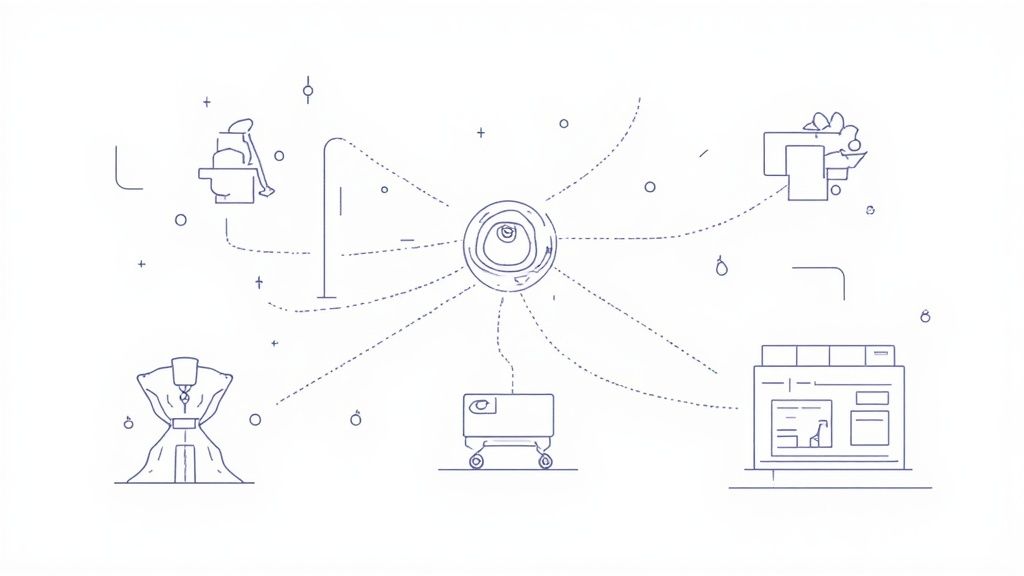
While flashy, customer-facing AI tends to grab all the headlines, the real engine of a profitable retail business is humming along behind the scenes. This is where machine learning for retail delivers some of its biggest financial wins—by taming the beast that is operations and supply chain management.
Your supply chain is a massive, interconnected network. A tiny hiccup in one spot, like a slightly off demand forecast, can trigger expensive ripple effects everywhere else. You end up with overstuffed warehouses or, much worse, empty shelves and angry customers.
Machine learning steps in to act as the central brain for this entire network. It digs through mountains of data to find patterns and predict what's next, flipping the script from reactive firefighting to proactive, automated efficiency.
Mastering Demand Forecasting with Predictive Analytics
The bedrock of any solid supply chain is knowing what your customers want to buy and when they'll want it. Old-school forecasting usually just looks at past sales, a method that gets caught flat-footed by sudden market shifts or viral trends.
Machine learning models, on the other hand, build far more accurate predictions by juggling a much richer set of data all at once.
- Historical Sales Data: This gives the model a solid baseline to work from.
- Seasonality and Holidays: It learns the predictable rhythms of your business, like the Black Friday rush or summer lulls.
- External Factors: Here's where it gets really smart. The model can pull in data like weather forecasts, local events, or even social media chatter to spot new trends before they even hit your radar.
This level of precision is a total game-changer. Research from McKinsey shows that AI-powered forecasting can slash errors by 30% to 50%. That directly translates to fewer stockouts and less cash locked up in inventory that isn't moving.
By accurately predicting demand, machine learning helps ensure the right products are in the right place at the right time. This simple principle is the key to maximizing sales while minimizing waste.
Streamlining Warehouse and Inventory Management
Once you know what to stock, the next puzzle is how to manage it all efficiently. A well-organized warehouse is the key to fast fulfillment and happy customers. Machine learning adds a powerful layer of intelligence to this physical space.
For instance, models can analyze which products are most frequently bought together and then optimize the physical layout of the warehouse. Placing those items closer to each other shaves precious seconds and minutes off the time it takes for staff or robots to pick and pack orders. This small change directly cuts labor costs and gets packages out the door faster.
Optimizing Logistics and Delivery Routes
The final leg of the journey is getting the product into your customer's hands. That "last mile" of delivery is famously expensive, often eating up more than half of your total shipping costs. Machine learning is the perfect tool to tackle this problem head-on.
Route optimization algorithms are a classic example. These systems crunch dozens of variables in real time to map out the most efficient delivery routes for your entire fleet.
They take everything into account:
- Current traffic patterns and road closures
- Specific delivery time windows and priorities
- Fuel consumption and vehicle capacity
By always finding the best path, these models can drastically lower fuel costs, shorten delivery times, and squeeze more deliveries into a single day. It's an operational win that saves you money and boosts the customer experience with faster, more reliable shipping.
Protecting Your Bottom Line with Fraud Detection
Finally, a crucial but often overlooked part of operational health is shielding your revenue from fraud. Machine learning algorithms are brilliant at this, constantly scanning transaction data to spot weird patterns that scream "fraud."
Unlike older, rule-based systems that just look for specific red flags, an ML model first learns what "normal" looks like for your business. It can then instantly flag anything that deviates from that baseline, like an unusually huge order from a brand-new account or a flurry of purchases from different locations. This lets you block bogus transactions before they ever go through, protecting both your business and your legitimate customers from financial headaches.
Implementing Your First Machine Learning Project
Jumping into machine learning doesn't have to be some massive, intimidating overhaul of your entire business. The real key is to start small, prove the value, and then build momentum from there. This approach breaks the whole process down into manageable steps, letting you focus on solving one clear, high-impact business problem first.
Think of it like testing out a new marketing channel. You wouldn't just dump your entire budget into it overnight, right? Of course not. You'd run a small pilot campaign, check the results, and then decide how to scale up. Your first machine learning for retail project should follow that same smart, step-by-step logic.
Start with a Specific Business Problem
The first, and honestly most critical, step is to nail down a clear, measurable problem you want to solve. A huge mistake is starting with the technology instead of the business need. A vague goal like "improve sales" is just too broad to be useful. A focused goal, on the other hand, is much more powerful.
Here are a few examples of well-defined problems to start with:
- Reduce cart abandonment: Can we predict which customers are about to leave their cart and send them a perfectly timed incentive?
- Improve product recommendations: Can we boost the click-through rate on our "recommended for you" section by 15%?
- Optimize inventory for a key product line: Can we forecast demand for our top 10 bestsellers to avoid running out of stock during the holidays?
Choosing a specific problem gives your project a clear finish line and makes it way easier to measure whether it was a success.
The goal of your first project isn't to revolutionize the company in 90 days. It's to score a tangible win that shows the ROI of machine learning and builds the confidence to invest more down the road.
Gather and Prepare Your Data
Once you have your problem defined, it's all about the data. Machine learning models are only as good as the data they learn from. This is where a lot of projects get stuck, so it's vital to get it right. You'll need to pull together the relevant data and make sure it’s clean and organized.
For an inventory forecasting project, for instance, you'd need:
- Historical Sales Data: Transaction records with all the details—product SKUs, quantities sold, and timestamps.
- Product Information: Details for each item, like its category, price, and other attributes.
- External Factors (Optional but powerful): Data on things like promotions, seasons, or holidays that you know affect sales.
This "data cleaning" phase means fixing errors, dealing with missing values, and getting everything into a consistent format. It’s not the most glamorous part of the job, but it is absolutely essential for building a model that actually works. For many retailers, this stage is a perfect opportunity to better understand and improve ecommerce sales by seeing which data points directly impact performance.
Choose Your Tools and Build a Pilot
With clean data in hand, you can finally start building. You don't need a huge team of data scientists to get started. Many user-friendly platforms today offer pre-built models for common retail problems like personalization or forecasting.
As you start putting your first machine learning project into motion, thinking about talent and staffing is also important. For those looking to build out a team, resources like the Hiring for AI in Non-Tech Industries: A Playbook for Retail can offer a really helpful playbook.
The key is to run a small-scale pilot project. Test your model on a limited slice of your business—for example, try a new recommendation algorithm on just 5% of your website traffic. This lets you measure its impact against a control group and prove its value before you commit to a full-scale rollout. Starting smart with a well-defined success story is the best way to weave machine learning for retail into your growth strategy.
What's Next for AI in Retail?
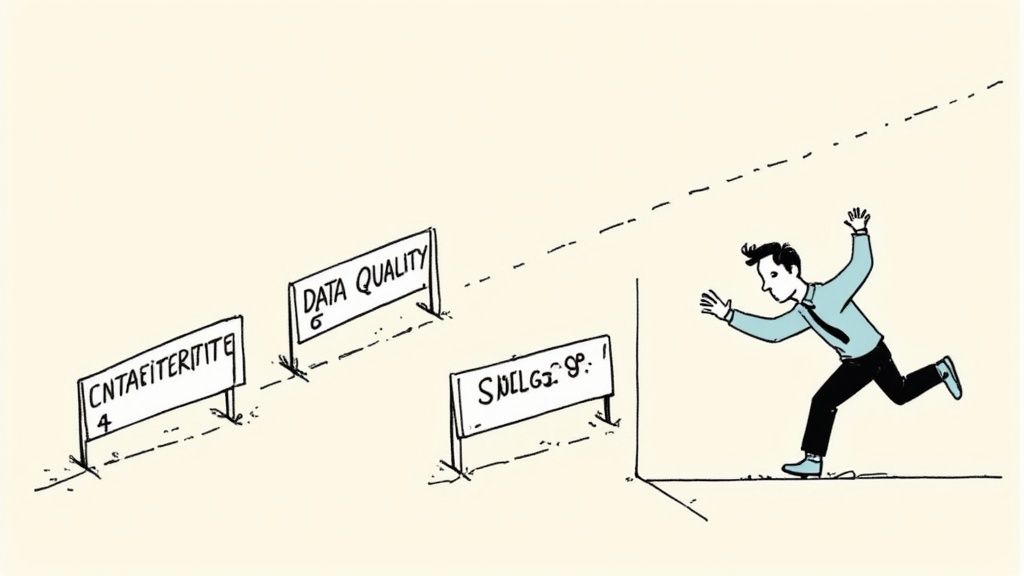
The world of machine learning for retail isn't sitting still. While the tools we have today are already incredibly powerful, the next wave of AI is about to unlock some seriously exciting possibilities. These aren't just lab experiments anymore; these trends are quickly moving into the real world, giving savvy brands new ways to build a major competitive edge.
Leading the charge is generative AI. You shouldn't think of it as just another analysis tool—it's more like a creative partner. Instead of just crunching past data, generative AI can actually create brand-new content from scratch. Imagine an AI that whips up five compelling, SEO-friendly product descriptions for a new pair of sneakers in seconds, each one aimed at a slightly different customer.
And it goes way beyond just text. This tech can generate marketing visuals on the fly, creating unique ad creatives or social media posts for specific campaigns. This lets retailers test ideas and get campaigns out the door at a speed that used to be unthinkable, freeing up their human teams for more important strategic work.
Generative AI in Practice
The applications are both practical and powerful, hitting on common pain points for retailers:
- Automated Content Creation: Instantly produce product descriptions, blog posts, and email marketing copy that sounds human.
- Visual Merchandising: Create unique lifestyle shots or product mockups without needing expensive, time-consuming photoshoots.
- Personalized Marketing: Develop hyper-specific ad copy and visuals for thousands of different customer segments, all at once.
The real magic of generative AI is how it scales creativity. It acts as a force multiplier, letting marketing and merchandising teams execute more ideas, faster, all while keeping the brand's voice consistent.
The Rise of Multimodal AI
Another huge leap forward is multimodal AI. This is a type of AI that understands the world a lot more like we do—by processing different kinds of information at the same time. A multimodal model doesn’t just see a product image or read a customer review; it connects the dots between them. It can look at a photo of a dress, read reviews that mention its fabric, and listen to an influencer's video feedback, blending all of it into one rich, cohesive understanding.
A major trend for 2025 is putting this capability to work to generate much deeper business insights. Retailers are starting to use multimodal AI to fine-tune their inventory by linking sales data with supplier emails and visual trends blowing up on social media. You can dive deeper into how this will reshape the industry in this detailed 2025 retail forecast.
Connecting Data for Deeper Insights
This ability to pull together different kinds of data gives businesses a much more complete picture of their customers and operations. For instance, a model could spot that products with "soft-focus" or "vintage-style" photos are getting more positive reviews about "comfort" and are selling out faster in a specific region.
That's a massive step up from analyzing data in separate silos. By seeing the connections between visual trends, customer feelings, and actual sales, retailers can make smarter, more confident decisions. These trends are closely related to the broader field of predictive analytics for retail, where the main goal is to get ahead of what's coming next.
Ultimately, these new technologies are pushing the boundaries of what machine learning for retail can do. They're paving the way for a future where AI doesn't just make existing processes more efficient, but actively helps shape the creative and strategic direction of the business to create truly standout customer experiences.
Answering Your Top Questions About Retail AI
Jumping into machine learning for retail always kicks up a few questions. It's a big topic, after all. So, I've put together some straight, practical answers to the four questions I hear most often from retailers exploring AI for the first time.
Let's clear up any confusion so you can move forward feeling confident.
How Much Data Do I Really Need?
It’s a common myth that you need "big data" to even get started. The truth? Quality beats quantity, every single time. A clean, well-organized dataset with a few thousand transactions is infinitely more useful than millions of messy, inconsistent records.
The key is to focus on a specific problem first. If you’re building a product recommendation engine, you need clean data showing which customers bought which products. Simple as that. For demand forecasting, you just need accurate historical sales data. Start with the high-quality data you already have—it's probably more powerful than you think.
The most important thing is having data that’s relevant to the business question you're trying to answer. A smaller, focused dataset will outperform a massive but irrelevant one every time.
What Is the Biggest Implementation Challenge?
Honestly, the technology itself usually isn't the biggest hurdle. The real challenges are data integration and setting clear goals. Most retailers have their data siloed in different systems that don't talk to each other—your e-commerce platform, your POS system, your marketing tools, and so on.
Pulling all that data into one unified place is the critical first step. The other roadblock is not having a clear business objective. Without a specific, measurable goal (like "reduce stockouts by 15%"), any machine learning project can quickly lose direction and fail to deliver real value.
Can a Small E-commerce Store Use Machine Learning?
Absolutely. The idea that machine learning is just for giants like Amazon is completely outdated. Today, there are tons of accessible tools and platforms that level the playing field for smaller businesses.
Here’s how smaller stores can jump in:
- Shopify Apps: The Shopify ecosystem is packed with apps that have built-in machine learning for things like personalization and fraud detection.
- Email Marketing Platforms: Tools like Klaviyo or Mailchimp already use ML to optimize send times and segment your audience automatically.
- Affordable AI Platforms: There's a growing number of services offering user-friendly, pre-built models designed specifically for e-commerce.
You don't need a team of data scientists to start using machine learning for retail and see a real impact.
How Can I Measure the ROI?
Measuring the return on investment (ROI) is non-negotiable; you have to prove the value of any AI project. The trick is to tie your project to concrete business metrics before you even write a single line of code.
You should be tracking metrics like:
- Conversion Rate Lift: Compare the conversion rates of shoppers who interact with an ML tool (like a recommendation engine) versus those who don't.
- Increase in Average Order Value (AOV): Are your personalized upsells leading to bigger carts? Measure it.
- Operational Savings: Calculate the money saved from reducing inventory waste or making your logistics more efficient.
By defining these key performance indicators (KPIs) upfront, you'll have no trouble demonstrating the financial impact your machine learning efforts are having.






